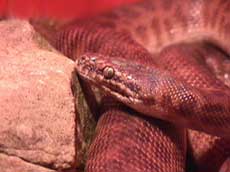Home » Literature Archives » The New Skin of a Buddhist Robe
THE NEW SKIN OF A BUDDHIST ROBE
by Yin Shan Shakya

I've spent many years breeding snakes, and like everybody else who is serious about snake husbandry I've always found these creatures compelling in their mysterious ways. Usually science can dissipate the aura of wonderment that surrounds creatures that are viewed with such fear and awe, but somehow snakes defy the scrutiny. They've been venerated and studied since bipedal man first learned the lesson of "Don't tread on me"; but part of the serpent's great mystique, I think, is that their infinite variety keeps us from being sure of any lesson they teach. Sometimes they give us information that it takes us years to process. They don't give frivolous lessons: what they impart in some strange way is always deeply significant.
Years ago, when I was still a boy and living in my parents house, I raised as many snakes as I could con my parents into letting me keep. My mother was scared of them and my father, while glad to see I had a hobby that kept me off the streets, still didn't appreciate having to deal with my mom's anxiety. So I had to raise them in what you might call a "low keyed" environment. All my equipment was kept in my bedroom and the deal was that my mother would never go into my bedroom. For a long time, it wasn't a bad arrangement.
Now, some snakes bear their young alive - these are called ovoviviparous, while others lay eggs - these are oviparous. The eggs need to be carefully tended by the mother snake. If they are to become viable hatchlings a certain temperature has to be maintained. We can't be sure of the time that the eggs will hatch and the snakes emerge as living breathing entities.
At one particular time I had a clutch of four eggs incubating in my bedroom. The clutch was of "Children's Pythons" (Liasis childreni) a small species of 4 to 5 feet that originates in Australia. I kept them in my incubator with soil and vermiculite - which helps keep the humidity at a constant level.
I'd come home from school every day and check on the eggs... waiting.. waiting. One day I came home and noticed that the top of the incubator was slightly off center. It had been moved. I rushed to the incubator to see if some of the hatchlings had made it out of their warm safe egg environment into the world. When I looked in the incubator I was astonished. All four eggs had hatched and the broken shells lay discarded in the soil. I picked up each newborn and examined it, delighted to see how much energy and vigor each had. But the problem was that while four eggs hatched, I could find only three hatchlings. One was missing. It had escaped - the reason why the incubator lid was not quite centered. The hatchling was lost somewhere in my bedroom.... which was not the easiest place to be found even if you wanted to be found..
When Children's Pythons are born they are about the same size as a new #2 pencil. Skinny, very quick, and for the most part, angry.
This newborn could of been anywhere. He had a Disneyland of possibilities. Sneakers, shoes, piles of clothes, sheets, pillows, blankets, books, furniture, games, drawers - open or closed, closets, pockets of coats inside closets, rainwear, fishing gear, bows and arrows and quivers, basketballs, roller skates, the whole bathroom. Where do you start looking for a creature that can wriggle under improbable things or stay perfectly still, hiding in plain sight. Of course I needed to find the little guy, but where should I look? The places I feared most were the heating duct for him and under the bedroom door and out into the hall for my mom. I checked the bathroom and when I was certain the snake wasn't in there I stuffed a towel under the door and concentrated on my room. For hours I made my way through all the mounds of laundry.. clean and dirty....nothing. I looked everywhere... nothing. It was dinner time and my mom was calling. I couldn't put off the big confession. It was time to tell my parents, and I knew this was going to be a rough one. So.....
I came downstairs and tried to sound casual as I mentioned that I had lost a baby snake. My mother gasped and my father demanded to know how I could be so careless; and what it all meant was now every time my mother picked up something she acted like there was bound to be a krait coiled behind it... She'd tremble and inhale in a quivering sigh and exhale with a "Thank you, Jesus!" kind of relief when nothing bit her. This went on for days.
All my relatives knew about the problem and they'd come over and pretend to be careful not to sit or step on the missing snake. They'd call me, "The Good Pytherd" and ask for my "Little lost pythette." I wasn't amused. I feared I'd find him shriveled up dead from dehydration. Snakes are cold blooded creatures. They need heat to survive; and a baby's first feeding should be given it soon after he bursts out of the egg case.
And yes it was a miracle when nearly ten days later I picked up a towel in the bathroom and there he was... two sad eyes looking up at me. He was weak and almost lifeless. I had found my little friend. It's customary to put newborn snakes into what is referred to as a "shoe box" which is a little plastic Tupperware container equipped with a place to hide.. some water, and a heat strips that run on the underside of the container. I put a newborn mouse, what is referred to as a "pinkie," into the box and gently laid the little guy down on some fresh shredded paper. He took some water and headed for the pinkie. I went to bed and buried my face in my pillow and cried with relief and joy.
Later, when I felt more scientific, I sexed them and learned that the three well-behaved snakes were females and that my adventurous friend was the lone male. This is an excellent ratio. It's always nice to have a higher female to male ratio when dealing with snakes since the females are the ones that produce babies when reaching maturity; and one male cam take on the challenge of spreading his seed with any or all females available.
So I raised my four Children's Pythons, calling my lone male "Mutton" - for 'lost sheep' and the poor orphan mutt he looked like when I finally found him. He became my special pet, one I knew I'd never be able to replace in my heart.
Snakes grow very quickly in their first three years. Just like people, they too have growing pains, but instead of having stretch marks or aches in their knees, they simply regenerate themselves and shed their skin. It's a way for the snake to repair what has been harmed through hunting or getting hurt by predators. They seem to be born anew with every shed. Their brilliance is recaptured as their old skin is sloughed off and new and colorful scales reappear as if someone has sanded their body down and put a couple of coats of varnish onto their new form. The most badly burned or injured snake repairs itself to continue on in a way that is unknown to most of the animal kingdom.
So Mutton became a prolific father and each time he did I was so proud. "Macho Mutton" I'd call him and I'd give him an extra mouse. And then my parents told me I had to get rid of my snakes because we were moving into an apartment. I sold my collection. I gave my dad all the money. I didn't want any of it.
Years passed and I finally raised snakes again, but only in an academic way. And I raised other snakes... no Children's Pythons. Some people think that a pet is just an animal and that if you lose one, you can simply replace it. But that's not true. We form a living connection with a living creature, a connection that has roots in the heart; and when the roots are torn out, it takes a very long time for the heart to heal. So I took care of them, but that was all I did.
And then I converted to Buddhism and eventually was ordained by my master at Fan Yun Temple. And one evening I stopped by my parent's house and there was a couple of relatives visiting.. these two were the ones who had called me "The Good Pytherd." My parents had a photograph of me wearing my Buddhist robes. My relatives were looking at it and one said mockingly, "You shed your old religion the way a snake sheds its skin."
From out of nowhere it came. "Do you mean," I asked in a voice that was a few decibels higher than normal, "that there is something frivolous about changing a skin or putting on a Buddhist robe? Life for any living creature is hard. We all get lost, and hurt, and separated from those we need and love. We all get battered and bruised trying to survive. It doesn't matter if you're an animal in the wild or a person. You get burned and cut and poisoned and starved; and just when you think you can't possibly go on, a hand lifts you up and helps you... and no matter whose hand that is, you're grateful to it. And then there is something innate in you that responds to this salvation. You become hungry to live again. Your wounds heal and the scabs slough off... just like a snake's skin... and you grow again. And if under that sloughed-off burned and scarred skin you come out wearing a shiny black robe and gold kesa... then you, my friend, are one lucky guy!"
I always knew the science behind the shedding; but not until that moment did I figure out the mystery of it. The next day I stopped at a few reptile stores. None had any Liasis childreni. But one guy thought he might be getting some in soon. I gave him my phone number.

